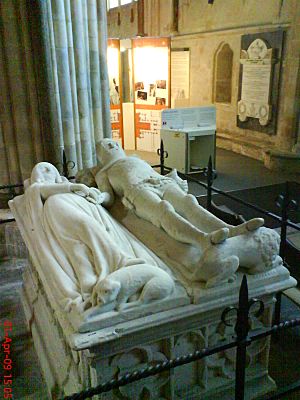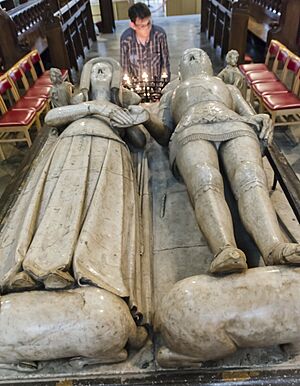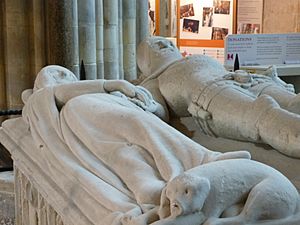An Arundel Tomb facts for kids
"An Arundel Tomb" is a famous poem by Philip Larkin. He wrote it in 1956. The poem was later put in his 1964 book, The Whitsun Weddings. It's about a stone monument Larkin saw in Chichester Cathedral. This monument shows an old English earl and his wife lying down with their hands joined. Many people think it's one of Larkin's best poems. The poem has 7 sections, called verses. Each verse has 6 lines and a rhyming pattern.
Contents
The Stone Monument
The stone monument in Chichester Cathedral is believed to be for Richard Fitzalan, 10th Earl of Arundel (who died in 1376) and his second wife, Eleanor of Lancaster (who died in 1372). They were first buried somewhere else. Their tomb might have been made by a famous builder named Henry Yevele. The statues were likely moved to Chichester Cathedral after their first burial place was closed down in 1537. We know for sure they were in the cathedral by 1635.
The man's statue wears armor. It has a lion symbol on his coat. A lion's head is also on his helmet. The woman's statue wears clothes typical of the 1300s. She has a veil, a wimple (a cloth covering the neck), a long dress, and a cloak. Her legs are crossed under her dress. Both figures have animals at their feet. The knight has a lion, which might mean bravery. The lady has a dog, which could mean loyalty. The knight's right hand is uncovered. The lady's right hand rests gently on his.
By the 1800s, the statues were quite damaged. They were also separated. In 1843, a restorer named Edward Richardson fixed them. He put them back side by side. He also carved their joined hands, because the original hands were gone. Richardson did a lot of research. It seems his repairs were very close to how the statues looked originally. However, the exact way their hands are joined was Richardson's idea. He might have seen similar hand-joining statues elsewhere.
The monument does not have names carved on it. Larkin mentioned "Latin names around the base" in his poem. This was probably a card placed by the cathedral. That card might have wrongly identified the couple as different people.
Why Their Hands Are Joined
The way their hands are joined is not very common. But it's not the only one like it in England from that time. Other examples include monuments for Thomas de Beauchamp, 11th Earl of Warwick and Katherine Mortimer, Countess of Warwick in Warwick. Also, statues of John of Gaunt, 1st Duke of Lancaster and Blanche of Lancaster in London once showed this pose. These people were often related or knew each other. It's possible that the same artist's workshop made all these monuments.
Later monuments also showed this hand-joining pose. Some were for the grandchildren of the Arundel Earl and Countess. For example, a brass monument for Sir William Arundel and his wife Agnes in Rochester Cathedral. Another is for Elizabeth Fitzalan, Duchess of Norfolk and Sir Robert Goushill in Hoveringham.
Today, many people, like Larkin, see the joined hands as a sign of romantic love. However, it was more likely meant to show the formal and legal promise of marriage.
The Poem's Meaning
Larkin visited Chichester Cathedral with his friend Monica Jones in 1956. He said the monument "very moved" him. He also said the statues were unlike any he had seen before. He finished the poem on February 20. It was first printed in the London Magazine in May 1956.
Larkin used the statues to think about big ideas. He thought about time, death, loyalty, and what love means on Earth. He wrote that his main idea was how the statues lasted so long. They became famous for something they might not have meant seriously. Writer Andrew Motion said Larkin used the hands to show the fight between time and human kindness.
The poem starts like this:
Side by side, their faces blurred,
The earl and countess lie in stone,
Their proper habits vaguely shown
As jointed armour, stiffened pleat,
And that faint hint of the absurd –
The little dogs under their feet.
And it ends with these famous lines:
[...] The stone fidelity
They hardly meant has come to be
Their final blazon, and to prove
Our almost-instinct almost true:
What will survive of us is love.
The last line is one of Larkin's most famous. If you read it alone, it sounds like love lasts forever. But the whole poem is more complex. It questions if love truly lasts beyond death. Still, the line feels true because we want to believe it. Larkin himself said:
Love isn't stronger than death just because statues hold hands for six hundred years.
But he also said later:
I think what survives of us is love, whether in the simple biological sense or just in terms of responding to life, making it happier, even if it's only making a joke.
"An Arundel Tomb" was one of three poems read at Larkin's memorial service. This was held in Westminster Abbey in 1986. The last two lines are also carved on his memorial stone there. Even so, Larkin once wrote that he found the poem "embarrassingly bad!" He thought it was trying too hard to be clever. He also said he never really liked it. He felt it was too romantic. He also learned that the joined hands were not as rare as he thought.
Other Poems Inspired by the Tomb
Other poems have also been inspired by the Arundel tomb.
- The male statue might have inspired John Keats's poem "La Belle Dame Sans Merci" in 1819.
- Charles Crocker (1797–1861) was a church worker and poet at Chichester Cathedral. He wrote a poem praising the restoration of the tomb.
- Gavin Ewart (1916–1995) wrote a poem called "An Arundel Tomb Revisited." It was inspired by Larkin's poem. It describes two lovers in bed holding hands, "like an Arundel tomb."
Images for kids
See Also









